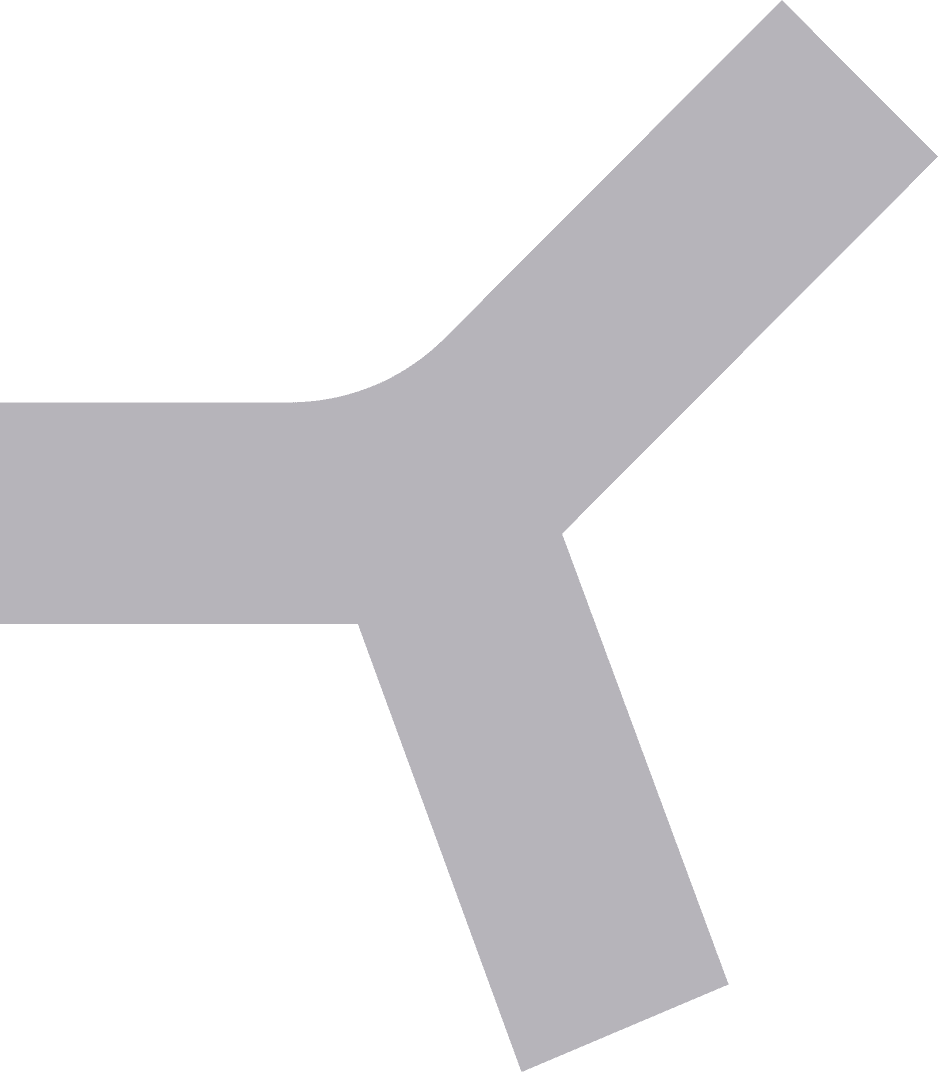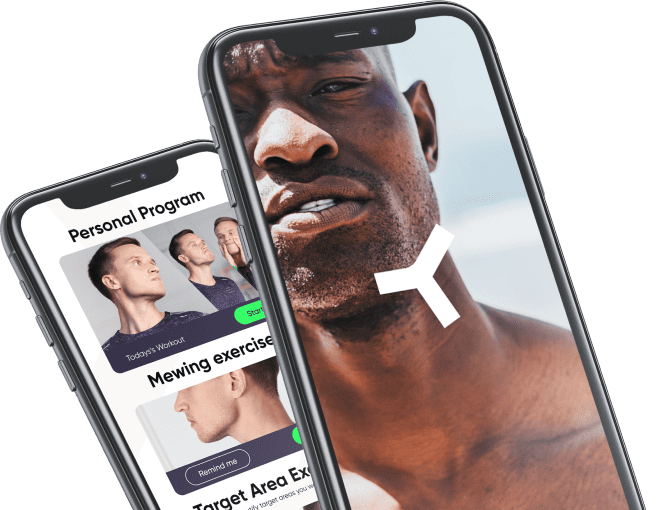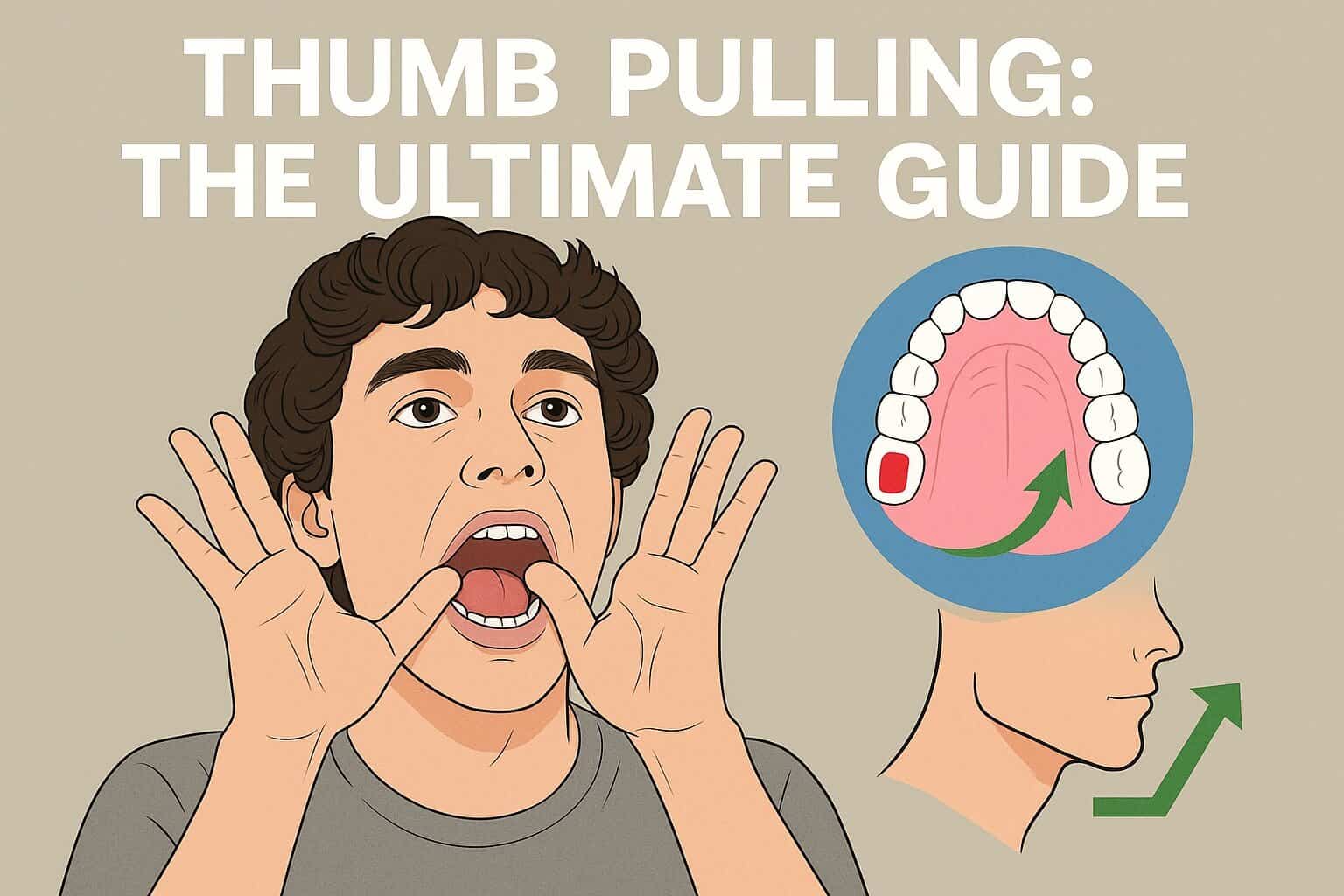
You don’t need expensive devices or surgery to start improving the way your face looks. Some methods are simple, natural, and can be done at home—thumb pulling is one of them.
This technique involves using your thumbs to apply gentle pressure inside the mouth, with the goal of encouraging subtle changes in jaw shape, posture, and facial balance. In this guide, we’ll break down what thumb pulling is, how to do it safely, where it can go wrong, and how it compares to other popular techniques like mewing and zygo pulling.
And if you’re curious which of these methods would work best for your own features, you can take the quick quiz below. You’ll get a face workout plan designed just for you, with short videos and simple tips that make it easy to begin right away.
What Is Thumb Pulling?
Thumb pulling is a DIY orthotropic method where you place your (clean) thumbs against the roof of the mouth to apply upward-forward or lateral pressure on the maxilla (upper jaw). It’s sometimes nicknamed “intraoral face pull.” People use this technique in hopes of encouraging subtle remodeling of the upper jaw, creating more tongue space, improving overall facial balance, and enhancing features like jawline definition or midface projection. The idea is rooted in bone’s natural response to mechanical load (see Wolff’s Law and craniofacial functional matrix theory: StatPearls; PMC: Mechanical Signaling for Bone; PMC: Functional Matrix Theory).
Think of it like gently shaping soft clay: a little bit of steady pressure, applied over time, can slowly change its form. Your upper jaw isn’t as soft as clay, of course, but bones and tissues can adapt to forces, especially when they’re consistent and gentle. Thumb pulling is simply a way of guiding that process with your own hands.
Does Thumb Pulling Work?
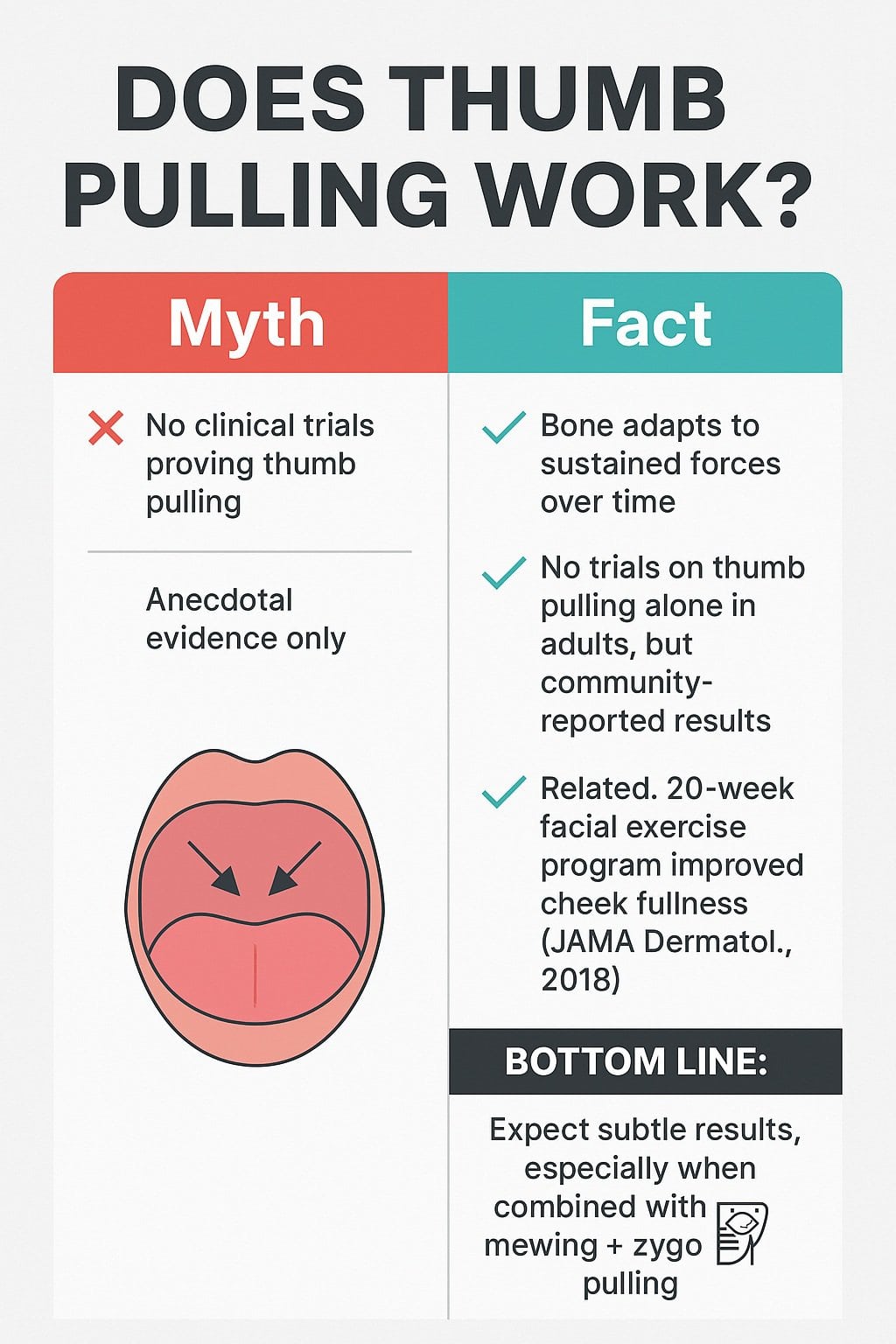
There’s no solid scientific research proving thumb pulling on its own—but there’s a huge amount of anecdotal evidence from communities showing it can make a difference, especially when combined with other face exercises like mewing and zygo pulling.
- Why it might: Bone adapts to load over time, and orthodontics routinely uses sustained forces to change bone/teeth relationships. See overviews in StatPearls and PMC.
- What we know for sure: There are no randomized clinical trials isolating “thumb pulling” in adults. Evidence today is largely anecdotal and community-reported. A balanced mainstream explainer summarizes the claims and cautions.
- Related evidence (soft tissue): A 20-week facial exercise program improved cheek fullness and perceived age in a pilot study (JAMA Dermatology, 2018; university summary: Northwestern Medicine), supporting that some appearance changes are possible through exercises—even if bony change is limited.
Bottom line: Expect subtle improvements that compound when you stack techniques (mewing + thumb pulling + zygo pulling) and good habits, rather than dramatic overnight “forward growth.”
Real-World Proof: Before & After (Stacked Techniques)

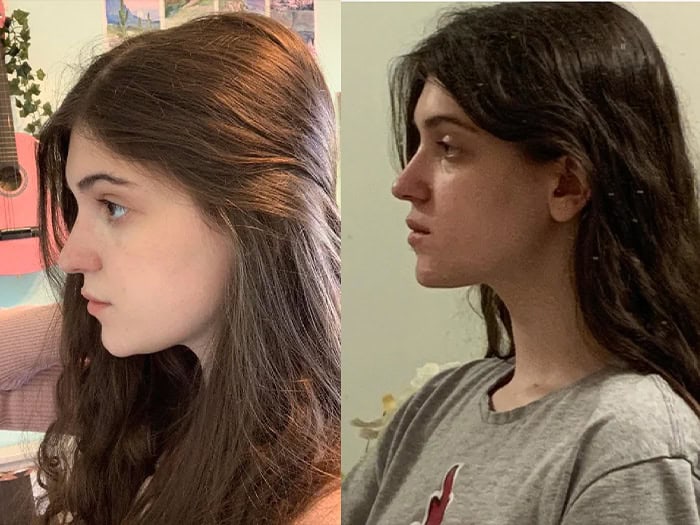
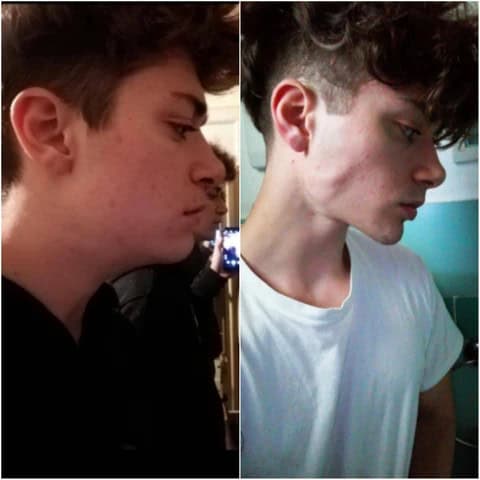
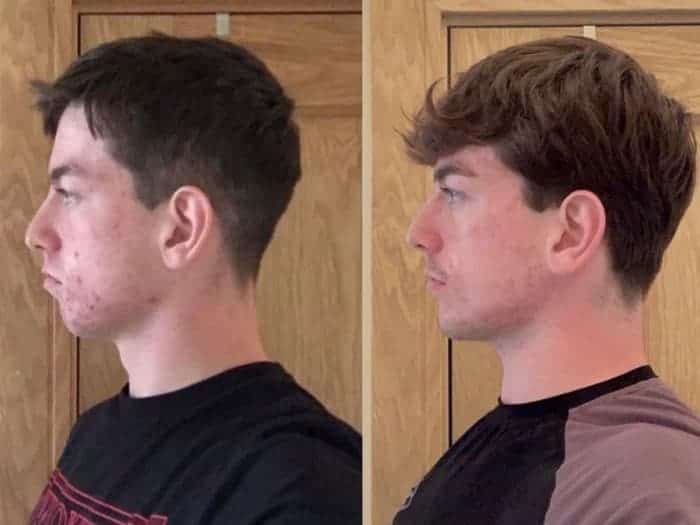
See dozens of before and after transformations where people combined mewing with facial exercises (including zygo and thumb pulling). These outcomes illustrate what disciplined routines can achieve over months, especially in younger users. (Results vary.)
How to Do Thumb Pulling (Step-by-Step Tutorial)
- Wash hands; trim nails. Optional: disposable finger cots.
- Stand straight against the wall. Push your shoulders out, neck straight and have every part of your body touching the wall except your heels. You heels should be slightly pushed forward for a perfect posture.
- Hinge your chin towards your neck (learn how to do chin tucking exercises).
- Place your thumb pads on the palate (roof of mouth)—not on the teeth or gums.
- Pulling direction:
- Forward growth focus: Press upward and slightly forward behind the incisive papilla (just behind front teeth) without touching teeth.
- Lateral thumb pulling: Press upward-outward along each side of the palate to encourage width (avoid tooth contact).
- Dosage: 30–60-second holds; 5–10 total minutes/day for beginners. Discomfort is okay; sharp pain is not.
- Symmetry: Distribute time/force evenly left vs right.
- Don’t forget: nasal breathe, relaxed jaw, light chin tucking for alignment.
- Stack it: Immediately follow with focused mewing to “set” posture.
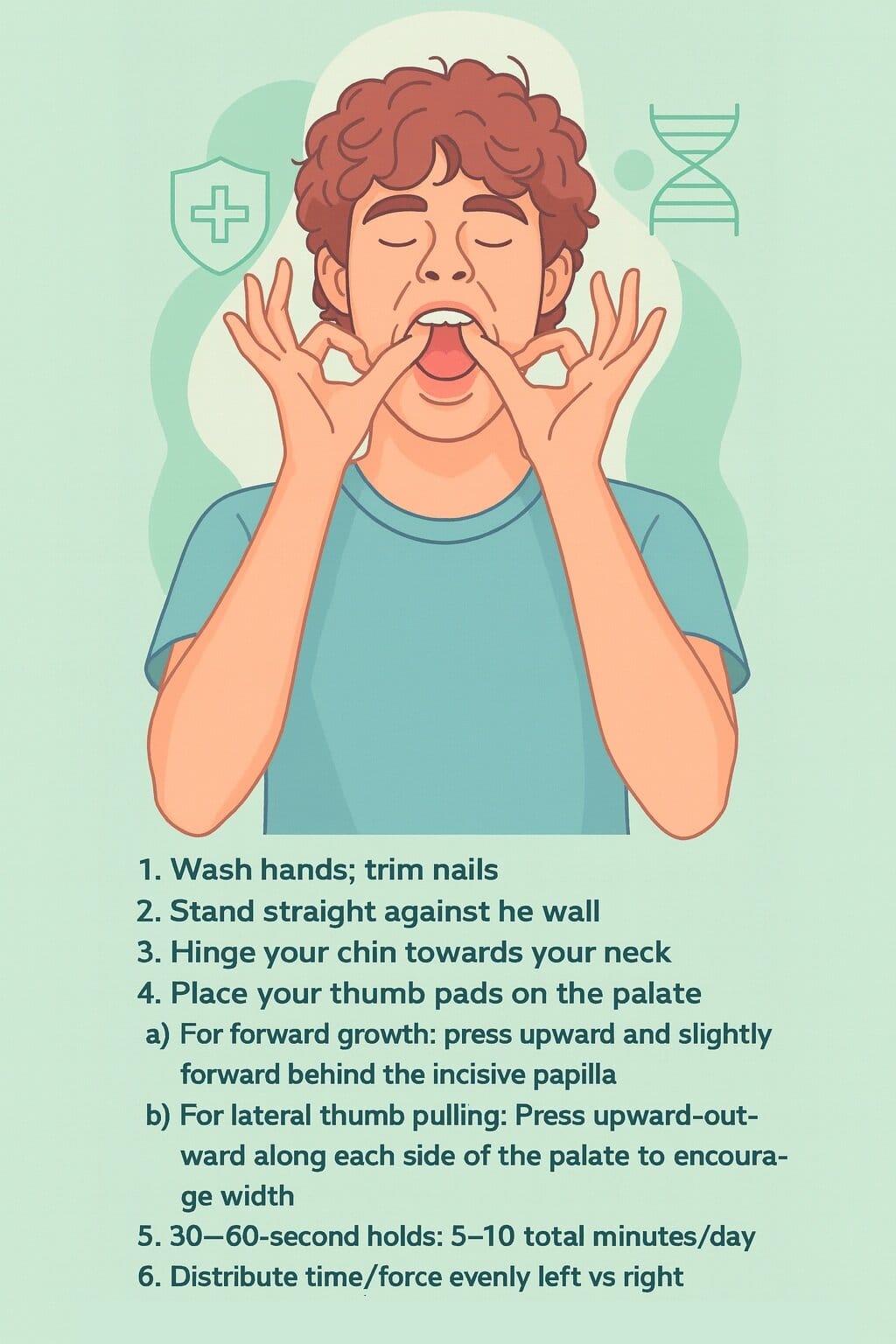
Technique cautions echoed in community guides and discussions: “Pull on bone, not teeth”; start gently; stop if it hurts.
If you want extra guidance and a routine that fits your face and goals, the Mewing.coach app can build you a personalized workout plan. It includes thumb pulling along with other proven exercises, plus simple video demos to make sure you’re doing everything correctly.
Lateral vs. Forward Thumb Pulling
Not all thumb pulling is the same—there are two main variations that target slightly different outcomes:
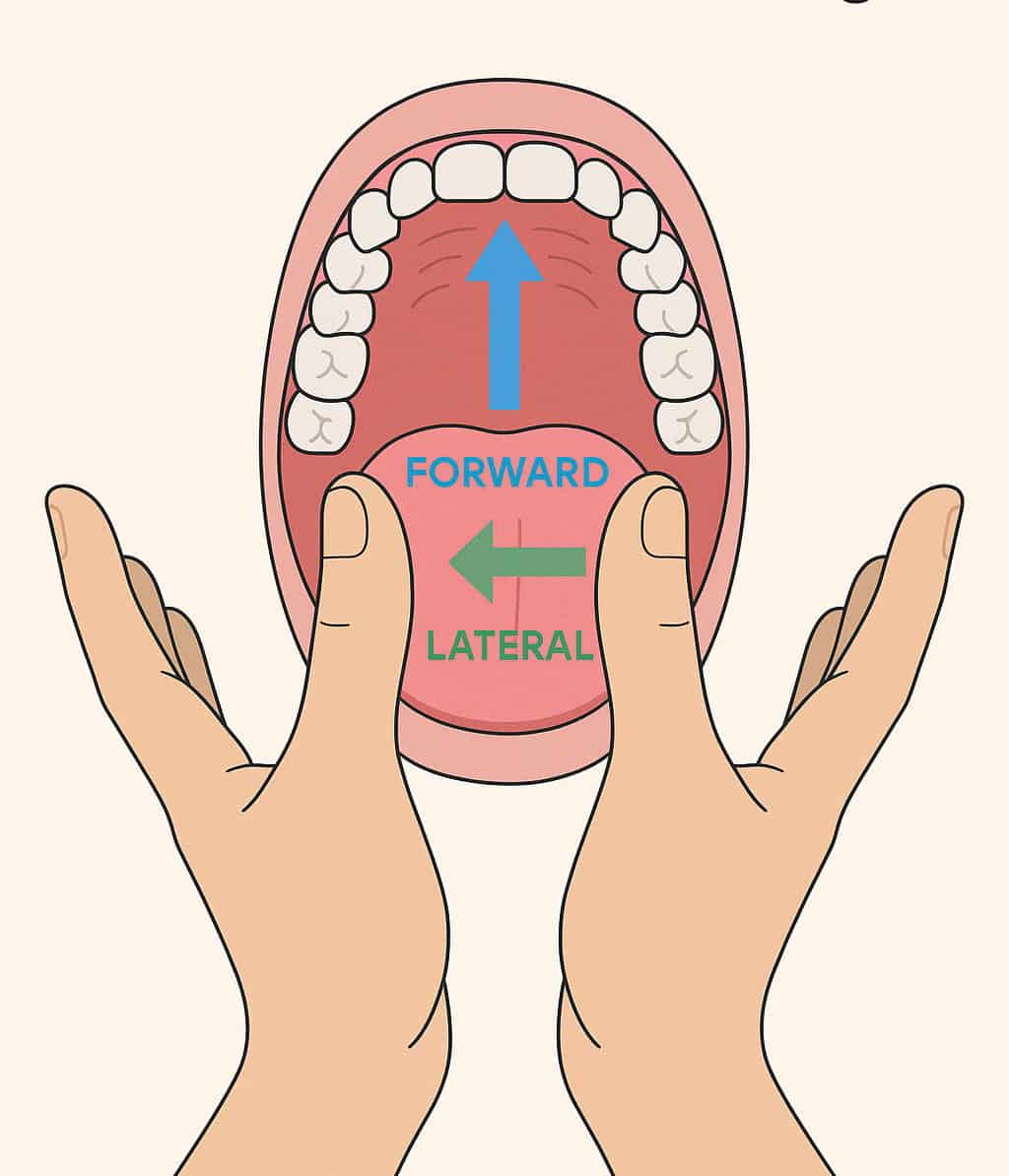
Forward thumb pulling
This version focuses on pressing upward and gently forward, just behind the front teeth (at the incisive papilla). The idea is to encourage the upper jaw (maxilla) to project slightly forward, which can make the midface look more defined over time. Forward thumb pulling is best used sparingly and with full control, since pushing too hard or too often can cause strain or discomfort. Think of it as giving the midface a subtle “nudge” forward, rather than trying to force major movement.
Lateral thumb pulling:
Here the thumbs press upward and outward along each side of the palate, avoiding direct contact with the teeth. This technique aims to support a wider palate, which can improve tongue space, help create a broader smile arc, and potentially make the face look more balanced. Because the force is spread out across the palate, lateral pulls are often considered gentler and safer, especially for beginners. Imagine trying to stretch dough outward evenly—that’s similar to what lateral thumb pulling is attempting to do for the palate.
Key takeaway:
Forward pulling is about projection (how far the midface comes forward), while lateral pulling is about width (how broad the palate and smile become). Many people combine both in small doses, but it’s important to stay gentle, consistent, and balanced to avoid strain or asymmetry.
Thumb Pulling vs. Mewing vs. Zygo Pulling
Each of these techniques aims to improve facial structure in different ways. Mewing focuses on long-term posture, thumb pulling applies direct force for potential skeletal change, and zygo pulling works more on soft tissue tone. Understanding their strengths and limits makes it easier to see how they complement each other rather than compete.
| Technique | Pros | Cons |
|---|---|---|
| Mewing (tongue posture) | Natural, 24/7, proven posture benefits | Very slow, subtle results in adults |
| Thumb Pulling | Direct force on maxilla, active | Risk of misuse, anecdotal evidence only |
| Zygo Pulling (cheekbone massage) | Boosts cheek definition, safe | Mostly soft tissue, not bone |
- Mewing (tongue posture): All-day habit; posture, airway, and subtle skeletal guidance. Slow but foundational.
- Thumb pulling: Short, targeted sessions; active stimulus for projection/width. Evidence is anecdotal; technique-sensitive.
- Zygo pulling: Intraoral cheekbone lift/massage; useful for soft-tissue tone and midface “lift.”
Best practice: Combine all three. Many of the clearest results come from stacking techniques plus lifestyle habits (nasal breathing, chewing, sleep, posture).
The Looksmaxxing Stack (Daily Routine)
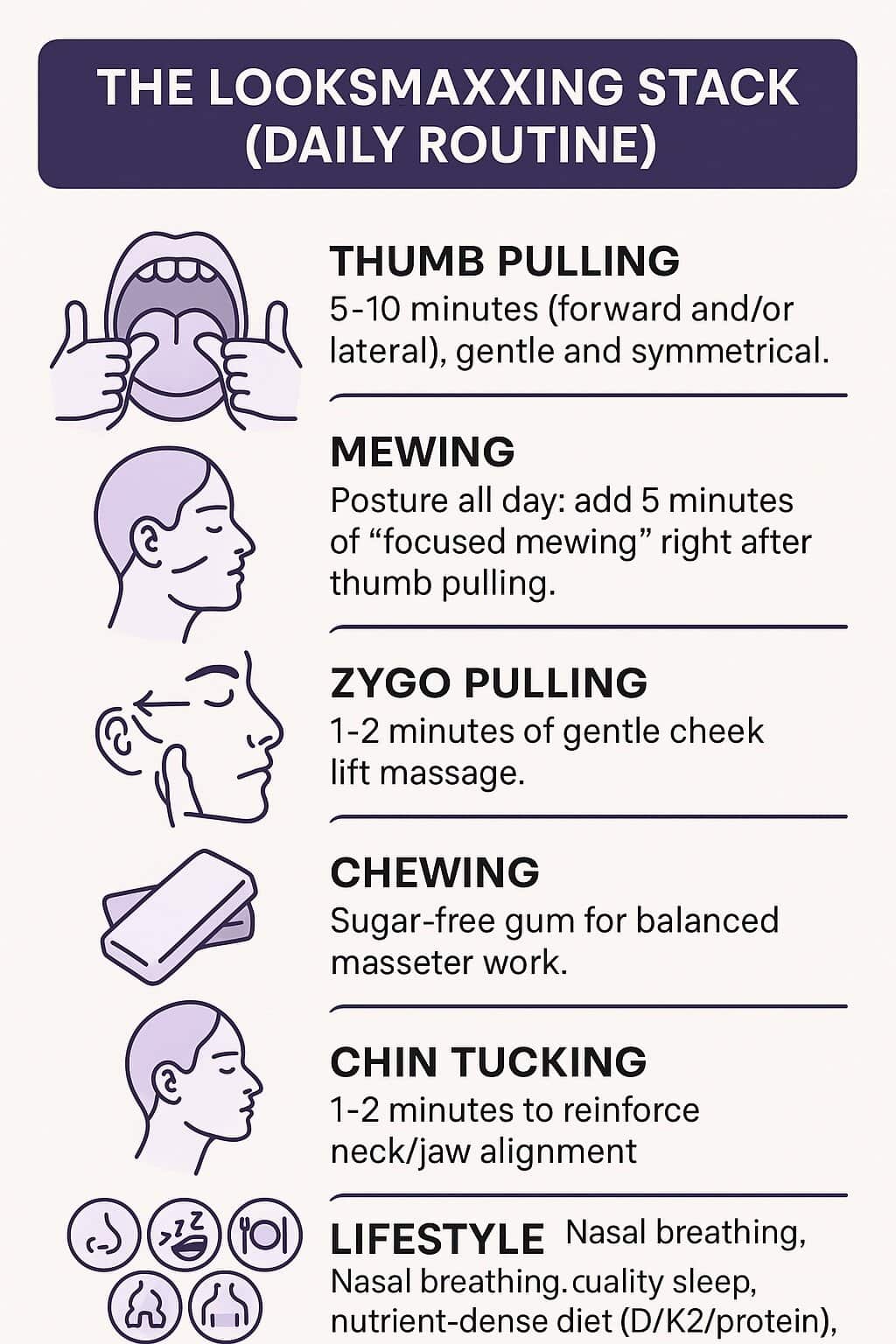
- Thumb pulling: 5–10 minutes (forward and/or lateral), gentle and symmetrical.
- Mewing: Posture all day; add 5 minutes of “focused mewing” right after thumb pulling.
- Zygo pulling: 1–2 minutes of gentle cheek lift massage.
- Chewing: Sugar-free jaw gum for balanced masseter work.
- Chin tucking: 1–2 minutes to reinforce neck/jaw alignment.
- Lifestyle: Nasal breathing, quality sleep, nutrient-dense diet (D/K2/protein), bodyfat management.
If you want to make this routine stick, the Mewing.coach app can help. It not only gives you guided facial exercises but also daily reminders, progress tracking, and access to a community of over 50,000 users who share tips and results. Staying consistent is easier when you’re not doing it alone.
Benefits You May Notice
- Subtle improvement in midface projection and smile width.
- More room for the tongue → easier mewing and nasal breathing.
- Sharper jawline & cheek definition when combined with chewing and zygo work.
- Confidence boost from taking action (key for looksmax).
- Free, at-home method; no devices required.
Risks, Side Effects & “Gone Wrong” Cases
- Teeth/dental work strain: Never press on teeth—only the palate.
- TMJ irritation or asymmetry: Overdoing force or favoring one side can trigger jaw popping/tension. Reduce intensity, rest, and reassess technique.
- Soreness/headaches: Ease in gradually; sessions should feel like pressure, not pain.
- With braces: Generally avoid unless your orthodontist approves; competing forces can interfere with treatment.
- Hygiene: Dirty hands increase infection risk—keep it clean.
Even mainstream explainers flag the lack of clinical data and the importance of caution.
How It Compares to Medical Approaches (Perspective)
Orthodontic appliances (e.g., expanders, miniscrew-assisted devices) change adult arches with controlled, sustained force, sometimes loosening sutures so the tongue can help maintain forward/lateral remodeling (PMC case discussion). Thumb pulling is a gentle, DIY stimulus—not a substitute for indicated medical care—but it can be a sensible first step for natural looksmaxxing before considering invasive options.
FAQ.
How long for results?
It depends on the person. Younger users may see changes faster, but many adults also report positive results with consistency. Expect weeks to months for subtle shifts, and track progress with photos to spot improvements over time.
Is it dangerous?
Not if done correctly. Gentle, even pressure on the palate is safe, but pressing too hard or unevenly can cause strain. For best results and guidance, follow this tutorial or use the Mewing.coach app to avoid mistakes.
Thumb pulling with braces?
Generally not recommended. The forces can interfere with orthodontic treatment, so always ask your orthodontist before trying. If you have braces, consult a professional first.
It hurts—what now?
Thumb pulling should feel like pressure, not pain. Stop and check your technique—press on the palate, not teeth. If pain continues, it could be an issue like TMJ, and you should consult a dentist or doctor before continuing.
Quick Safety Checklist
- Palate only (never teeth).
- Gentle, symmetric force; short holds.
- Posture: nasal breathing + chin tuck.
- Stack with mewing immediately after.
- Back off if you feel joint pain or sharp pain.
Your Next Step: Personalize Your Looksmax Plan
Don’t guess—get a customized routine that integrates thumb pulling, mewing, zygo pulling, chewing, and chin tucking with reminders and progress tracking.
Get your tailored plan and start capturing your own before and after results—safely and consistently.
References
- JAMA Dermatology (2018): Association of Facial Exercise With Appearance of Aging | Northwestern Medicine summary
- StatPearls: Physiology, Bone Remodeling
- PMC: Mechanical Signaling for Bone Modeling & Remodeling
- PMC: Combating Constraints of the Functional Matrix (craniofacial growth)
- PMC: Maxillary remodeling after growth cessation (orthodontic expansion context)

